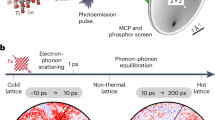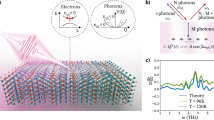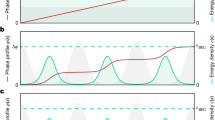Abstract
Semiconductor microcavities offer unique systems in which to investigate the physics of weakly interacting bosons. Their elementary excitations, polaritons—mixtures of excitons and photons—can accumulate in macroscopically degenerate states to form various types of condensate in a wide range of experimental configurations, under either incoherent1,2 or coherent3,4 excitation. Condensates of polaritons have been put forward as candidates for superfluidity5,6, and the formation of vortices7 as well as elementary excitations with linear dispersion8 are actively sought as evidence to support this. Here, using a coherent excitation triggered by a short optical pulse, we have created and set in motion a macroscopically degenerate state of polaritons that can be made to collide with a variety of defects present in the microcavity. Our experiments show striking manifestations of a coherent light–matter packet, travelling at high speed (of the order of one per cent of the speed of light) and displaying collective dynamics consistent with superfluidity, although one of a highly unusual character as it involves an out-of-equilibrium dissipative system. Our main results are the observation of a linear polariton dispersion accompanied by diffusionless motion; flow without resistance when crossing an obstacle; suppression of Rayleigh scattering; and splitting into two fluids when the size of the obstacle is comparable to the size of the wave packet. This work opens the way to the investigation of new phenomenology of out-of-equilibrium condensates.
This is a preview of subscription content, access via your institution
Access options
Subscribe to this journal
Receive 51 print issues and online access
$199.00 per year
only $3.90 per issue
Buy this article
- Purchase on Springer Link
- Instant access to full article PDF
Prices may be subject to local taxes which are calculated during checkout





Similar content being viewed by others
References
Kasprzak, J. et al. Bose–Einstein condensation of exciton polaritons. Nature 443, 409–414 (2006)
Balili, R., Hartwell, V., Snoke, D., Pfeiffer, L. & West, K. Bose-Einstein condensation of microcavity polaritons in a trap. Science 316, 1007–1010 (2007)
Stevenson, R. M. et al. Continuous wave observation of massive polariton redistribution by stimulated scattering in semiconductor microcavities. Phys. Rev. Lett. 85, 3680–3683 (2000)
Saba, M. et al. High-temperature ultrafast polariton parametric amplification in semiconductor microcavities. Nature 414, 731–735 (2001)
Kavokin, A., Malpuech, G. & Laussy, F. P. Polariton laser and polariton superfluidity in microcavities. Phys. Lett. A 306, 187–199 (2003)
Carusotto, I. & Ciuti, C. Probing microcavity polariton superfluidity through resonant Rayleigh scattering. Phys. Rev. Lett. 93, 166401 (2004)
Lagoudakis, K. G. et al. Quantised vortices in an exciton–polariton fluid. Nature Phys. 4, 706–710 (2008)
Utsunomiya, S. et al. Observation of Bogoliubov excitations in exciton-polariton condensates. Nature Phys. 4, 700–705 (2008)
Abo-Shaeer, J. R., Raman, C., Vogels, J. M. & Ketterle, W. Observation of vortex lattices in Bose-Einstein condensates. Science 292, 476–479 (2001)
Onofrio, R. et al. Observation of superfluid flow in a Bose-Einstein condensed gas. Phys. Rev. Lett. 85, 2228–2231 (2000)
Steinhauer, J., Ozeri, R., Katz, N. & Davidson, N. Excitation spectrum of a Bose-Einstein condensate. Phys. Rev. Lett. 88, 120407 (2002)
Carusotto, I., Hu, S. X., Collins, L. A. & Smerzi, A. Bogoliubov-Cerenkov radiation in a Bose-Einstein condensate flowing against an obstacle. Phys. Rev. Lett. 97, 260403 (2006)
Weisbuch, C., Nishioka, M., Ishikawa, A. & Arakawa, Y. Observation of the coupled exciton-photon mode splitting in a semiconductor quantum microcavity. Phys. Rev. Lett. 69, 3314–3317 (1992)
Bajoni, D., Senellart, P., Lemaître, A. & Bloch, J. Photon lasing in GaAs microcavity: Similarities with a polariton condensate. Phys. Rev. B 76, 201305(R) (2007)
Lai, C. W. et al. Coherent zero-state and π-state in an exciton–polariton condensate array. Nature 450, 529–532 (2007)
Krizhanovskii, D. N. et al. Dominant effect of polariton-polariton interactions on the coherence of the microcavity optical parametric oscillator. Phys. Rev. Lett. 97, 097402 (2006)
Porras, D. & Tejedor, C. Linewidth of a polariton laser: Theoretical analysis of self-interaction effects. Phys. Rev. B 67, 161310 (2003)
Perrin, M., Senellart, P., Lemaître, A. & Bloch, J. Polariton relaxation in semiconductor microcavities: Efficiency of electron-polariton scattering. Phys. Rev. B 72, 075340 (2005)
Bolda, E. L., Chiao, R. Y. & Zurek, H. Dissipative optical flow in a nonlinear Fabry-Pérot cavity. Phys. Rev. Lett. 86, 416–419 (2001)
Ballarini, D. et al. Observation of long-lived polariton states in semiconductor microcavities across the parametric threshold. Preprint at 〈http://arxiv.org/abs/arXiv:0807.3224〉 (2008)
Freixanet, T., Sermage, B., Tiberj, A. & Planel, R. In-plane propagation of excitonic cavity polaritons. Phys. Rev. B 61, 7233–7236 (2000)
Langbein, W. et al. Polarization beats in ballistic propagation of exciton-polaritons in microcavities. Phys. Rev. B 75, 075323 (2007)
Szymanska, M. H., Keeling, J. & Littlewood, P. B. Nonequilibrium quantum condensation in an incoherently pumped dissipative system. Phys. Rev. Lett. 96, 230602 (2006)
Gurioli, M. et al. Weak localization of light in a disordered microcavity. Phys. Rev. Lett. 94, 183901 (2005)
Sanvitto, D. et al. Spatial structure and stability of the macroscopically occupied polariton state in the microcavity optical parametric oscillator. Phys. Rev. B 73, 241308(R) (2006)
Malpuech, G., Solnyshkov, D. D., Ouerdane, H., Glazov, M. M. & Shelykh, I. Bose glass and superfluid phase of cavity polaritons. Phys. Rev. Lett. 98, 206402 (2007)
Sanvitto, D., Whittaker, D. M., Skolnick, M. S. & Roberts, J. S. Continuous wave pump-probe experiment on a planar microcavity. Phys. Stat. Sol. (a) 202, 353–356 (2005)
Acknowledgements
We thank I. Carusotto, M. Wouters and N. Berloff for discussions and D. Steel for a critical reading of the manuscript. This work was partially supported by the Spanish Ministerio de Educación y Ciencia (MEC) (MAT2005-01388, NAN2004-09109-C04-04 & QOIT-CSD2006-00019), the Comunidad Autónoma de Madrid (S-0505/ESP-0200) and the IMDEA-Nanociencia. D.B. and E.d.V. acknowledge a scholarship (Formacion de Profesorado Universitario) of the Spanish MEC. D.S. and M.D.M. thank the Ramón y Cajal Programme.
Author information
Authors and Affiliations
Corresponding author
Supplementary information
Supplementary Figure
This file contains Supplementary Figure 1 with Legend (PDF 81 kb)
Supplementary Video 9
Supplementary Video 9 shows polaritons colliding with a large point defect in reciprocal space, corresponding to the images shown in Fig.5IIb. This is the k-space counterpart of Supplementary Video 8. (MOV 1006 kb)
Supplementary Video 1
Supplementary Video 1 shows appearance of the Rayleigh scattering circle in reciprocal space for a moving polariton droplet created with low pump power. (MOV 4768 kb)
Supplementary Video 2
Supplementary Video 2 shows polaritons, created with low pump power, getting trapped in a local defect. This is the real space counterpart of Supplementary Video 1. (MOV 3733 kb)
Supplementary Video 3
Supplementary Video 3 shows free polariton motion in real space, corresponding to the images shown in Fig.3a. (MOV 1007 kb)
Supplementary Video 4
Supplementary Video 4 shows free polariton motion in reciprocal space, corresponding to the images shown in Fig.3b. This is the k-space counterpart of Supplementary Video 3. (MOV 1089 kb)
Supplementary Video 5
Supplementary Video 5 shows simulation of a free polariton motion in real and k-space, corresponding to the image shown in Fig.4a (MOV 2273 kb)
Supplementary Video 6
Supplementary Video 6 shows polaritons colliding with a small point defect in real space, corresponding to the images shown in Fig.5Ia. (MOV 1698 kb)
Supplementary Video
Supplementary Video 7 shows polaritons colliding with a small point defect in reciprocal space, corresponding to the images shown in Fig.5Ib. This is the k-space counterpart of Supplementary Video 6. (MOV 793 kb)
Supplementary Video 8
Supplementary Video 8 shows polaritons colliding with a large point defect in real space, corresponding to the images shown in Fig.5IIa. (MOV 1572 kb)
Rights and permissions
About this article
Cite this article
Amo, A., Sanvitto, D., Laussy, F. et al. Collective fluid dynamics of a polariton condensate in a semiconductor microcavity. Nature 457, 291–295 (2009). https://doi.org/10.1038/nature07640
Received:
Accepted:
Issue Date:
DOI: https://doi.org/10.1038/nature07640
This article is cited by
-
Nonlinear topological symmetry protection in a dissipative system
Nature Communications (2024)
-
Uncovering temperature-dependent exciton-polariton relaxation mechanisms in hybrid organic-inorganic perovskites
Nature Communications (2023)
-
Interspecies exciton interactions lead to enhanced nonlinearity of dipolar excitons and polaritons in MoS2 homobilayers
Nature Communications (2023)
-
Onset of vortex clustering and inverse energy cascade in dissipative quantum fluids
Nature Photonics (2023)
-
Asynchronous locking in metamaterials of fluids of light and sound
Nature Communications (2023)
Comments
By submitting a comment you agree to abide by our Terms and Community Guidelines. If you find something abusive or that does not comply with our terms or guidelines please flag it as inappropriate.



